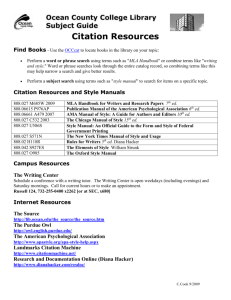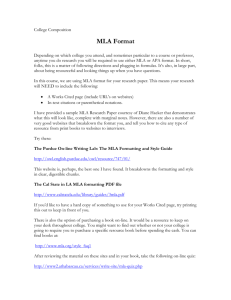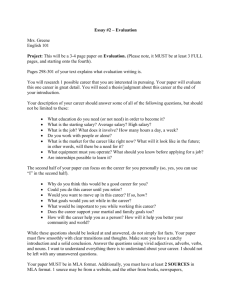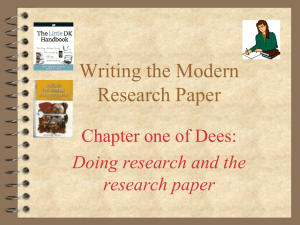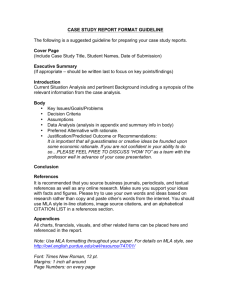The Basics of APA Style
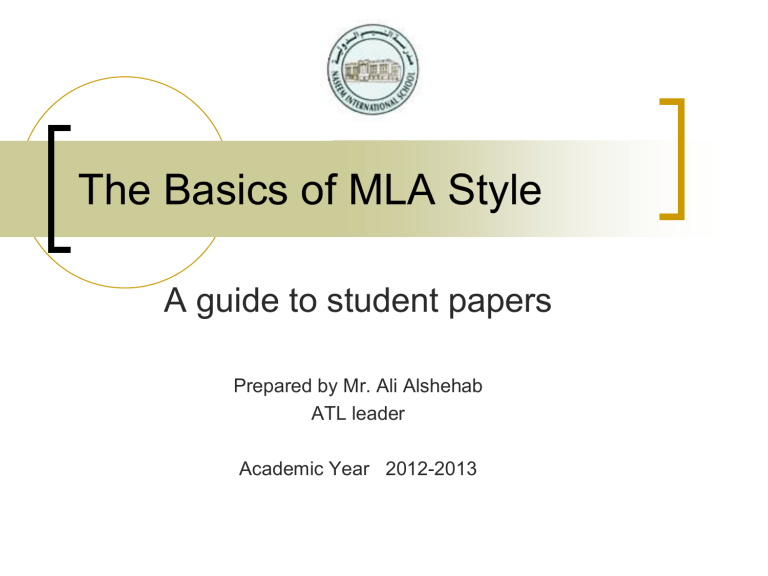
The Basics of MLA Style
A guide to student papers
Prepared by Mr. Ali Alshehab
ATL leader
Academic Year 2012-2013
Today’s Goals
Learn what MLA style is and why it is important
Learn about the standard MLA title page format
Learn basic documentation for books, journals, and websites
Learn the differences between methods of source integration: summarizing, paraphrasing, and quoting
Plagiarism
There are consequences for using others’ ideas without proper citation…or plagiarizing.
Plagiarizing can be many things from copying an essay from the internet, down to not fully paraphrasing a sentence from a source.
MLA…WHAT?
MLA stands for Modern Language
Association, and it is the format we most often write in when we are writing in the disciplines that are part of the
Humanities.
MLA- Required by the IB
MLA…WHAT?
MLA citation is really all about one thing…giving credit to the original author of a text or an idea. People’s intellectual property is legally theirs; it belongs to them.
Therefore, it is our responsibility as writers to give credit for ideas that are not our own.
When?
You need to cite anytime you use material from the text. If it isn’t your idea…cite it.
Paraphrases must be cited and they also must completely change the wording and the sentence structure of the original material. Paraphrases are a sticky wicket and they are a place where many people get in trouble with plagiarism.
Three areas of concern:
Part I: Formatting your paper
Part II: The reference list
Part I:
Formatting your paper
Use 8½ X 11 inch paper
12 point, New Times Roman, or similar font
1 inch margins
Double-space your text
Use a running header
Number pages consecutively, starting on the first page
Part I:
Formatting your paper
A title page is not necessary
Your name
Instructor
Course number
Date
Title of paper
Part I:
Formatting your paper
Indent the first line of each paragraph by five spaces (tab button)
Place tables and illustrations as close as possible to their related text
After the body of your paper comes the
Works Cited page
Documentation
Refers to the Works Cited page at the end of the paper
The List is labeled Works Cited (centered, no font changes) starts at the top of a new page continues page numbering from the last page of text is alphabetical is double spaced uses a hanging indent (1/2 inch – can be formatted from the Paragraph dialog box in MS Word)
Part II:
The reference list
Reference sources used in your paper must be listed
In MLA format, this page is labeled
“Works Cited”
List sources alphabetically by author’s last name (or title, if author not known)
Example
Works Cited
Heinerman, John. Heinerman’s Encyclopedia of Fruits, Vegetables and
Herbs . Paramus, NJ: Prentice Hall, 1988.
Kowalchik, Claire and William H. Hylton. Rodale’s Illustrated
Encyclopedia of Herbs . Emmaus, PA: Rodale Press, 1998.
Wardlaw, Gordon M. and Anne M. Smith. Contemporary Nutrition .
Boston: McGraw Hill, 2006.
Part II:
The reference list
MLA is used mostly in the humanities disciplines (history, literature, fine arts)
MLA style emphasizes brevity and clarity
The purpose of a reference list is to:
Identify and credit the sources you used
Enable the reader to locate your sources
Documenting Authors
One Author (list the author’s last name, first name):
Williams, John. A Crazy Book.
More than One Author (list first author’s last name, first name, and second author’s first name last name):
Stewart, Jessica, and Gail Smith. Panic: Writing Research Papers.
More than Three Authors (list first author’s last name, first name, et al. or list first author’s last name, first name, then remaining authors’ first names last names)
Francis, Marcus, et al. Forgetting Your College Papers.
or
Francis, Marcus, Jessica Cooke, Polly Cracker, and Harry Hall.
Forgetting Your College Papers.
Part II:
The reference list
Books
Lastname, Firstname. Title of book .
Location: Publisher, Year.
Lipson, Charles. Doing Honest Work in
College . Chicago: U of Chicago P, 2004.
Part II:
The reference list
Article in a journal
Lastname, Firstname . “Title of Article.”
Title of Journal volume (year): pp-pp.
Sacks, Samuel. “Fraud Risk: Are You
Prepared?” Journal of Accountancy
198.3 (2004): 57-63.
Part II:
The reference list-
Article in a Magazine
Lastname, Firstname . “Title of Article.” Title of
Magazine day month year: pp-pp.
Weintraub , Arlene, and Laura Cohan. “A Thousand-
Year Plan for Nuclear Waste.” Business Week 6
May 2002: 94-96.
Paul, Annie Murphy. “Self-Help: Shattering the Myths.”
Psychology Today Mar.-Apr. 2001: 60-68.
Documenting Websites
Model for an entire website:
Title of Web Page. Date of Posting on Website. Name of organization associated with the site. Date you viewed the site <electronic web address>.
Ex.
The Purdue OWL Family of Sites. 26 Aug. 2005. The Writing Lab and
OWL at Purdue and Purdue University. 23 April 2006
<http://owl.english.purdue.edu>.
Model for a page on a website:
“Name of Page on Website.” Main Website. Day Month Year <website>.
Ex.
"How to Make Vegetarian Chili." eHow.com. 10 May 2006
<http://www.ehow.com/how_10727_make-vegetarian-chili.html>.
Documenting an Online
Journal
Article from an Online Scholarly
Journal
Model:
Author’s Last Name, First Name. “Title of Article.”
Online Journal Volume.Issue (Year): # pars. Day
Month Year <website>.
Ex.
Davis, Alan. “A Nuclear Fusion Program.” Science
Today 70.11 (2008): 14 pars. 9 January 2009
<http://www.sciquest.edu/991.html>.
Part II:
The reference list: Online source
Author. “Title of Article.” Web Site. Editor. Site
Publisher or N.p., Date of Publication or n.d.
Medium of Publication (Web). Date of access.
<URL optional>.
Work Cited only on the Web, with URL [MLA 5.6.1]
Lye, John. “Some Notes on Realism.” Dept. of English Language and
Literature, Brock U. 22 Apr. 2008. Web. 25 Aug. 2009.
<http://www.brocku.ca/english/courses/2F55/realism.php>.
Part II:
The reference list: Online source
Entire Web site, no author
Title of Web site. Editor. Electronic publication info including version #, date of publication or latest update. Name of any sponsoring organization. Date of access <URL>.
Jane Austen Information Page. Ed. Henry Churchyard. 6 Sept. 2000. 15 June 2002
<http://pemberly.com/janeinfo/janeinfo.html>.
Part II:
The reference list: Online source
Online Book:
Fawcett, Shaun. Writing Success
Secrets. 2004. 15 Sept. 2006
‹ http://www.writinghelptools.com/secre ts.html
› .
Part II:
The reference list
Page on a web site, with author.
Firstname, Lastname. “Title of Page.” Name of
Web site. Date of publication or latest update. Sponsoring organization. Date of access <URL>.
Stolley, Karl. “MLA Formatting and Style
Guide.” The OWL at Purdue.10 May 2006.
Purdue University Writing Lab. 12 May 2006
<http://owl.english.purdue.edu/owl/resource/
557/01/>.
Let us practice:
"Plagiarism." Wikipedia, The Free
Encyclopedia . Wikimedia Foundation,
Inc. 22 July 2004. Web. 10 Aug. 2004
Other types!!!
Online Interview Transcript:
Griffin, Thomas. Interview with Matt Damon. The Gazette. August
2006. 12 Sept. 2007 ‹ http://www.montrealgazette.com/entertain/
0807/Damon/interview.html
› .
E-Mail Communication:
Bremer, Fred. "Re: Global Climate Change." E-mail to Rachel Heinz.
27 July 2007.
Online Posting:
Gravely, S. "Business Letter Writing." Online posting. 12 June
2007. Write Place Web log. 17 Sept. 2007 ‹ http:// www.writinghelptools.com/blog/ › .
Why Source Integration?
Quotations, paraphrases, and summaries
provide support for claims or add credibility to your writing refer to work that leads up to the work you are now doing give examples of several points of view on a subject call attention to a position that you wish to agree or disagree with highlight a particularly striking phrase, sentence, or passage by quoting the original distance yourself from the original by quoting it in order to cue readers that the words are not your own expand the breadth or depth of your writing
Quoting, paraphrasing, and summarizing. (2004). Purdue University Online Writing Lab. Retrieved September 28, 2007, from http://owl.english.purdue.edu/handouts/research/r_quotprsum.html
Choosing Text to Integrate
1.
2.
3.
4.
Read the entire text, noting the key points and main ideas.
Summarize in your own words what the single main idea of the essay is.
Paraphrase important supporting points that come up in the essay.
Consider any words, phrases, or brief passages that you believe should be quoted directly.
Quoting, paraphrasing, and summarizing. (2004). Purdue University Online Writing Lab. Retrieved September 28, 2007, from http://owl.english.purdue.edu/handouts/research/r_quotprsum.html
Summarizing
When you summarize, you put the main idea(s) into your own words, including only the main point(s).
Summarized ideas must be attributed to the original source.
Summaries are significantly shorter than the original.
Summaries take a broad overview of source material.
Quoting, paraphrasing, and summarizing. (2004). Purdue University Online Writing Lab. Retrieved September 28, 2007, from http://owl.english.purdue.edu/handouts/research/r_quotprsum.html
Paraphrasing
Paraphrasing involves putting a passage from source material into your own words.
Attribute paraphrases to their original sources.
Paraphrases are usually shorter than the original passage.
Paraphrases take a somewhat broader segment of the source and condense it slightly.
Quoting
Quotations must be identical to the original.
Quotations use a narrow segment of the source.
They must match the source document word for word and must be attributed to the original author.
Use quotes when the actual words are so integral to the discussion that they cannot be replaced.
Use quotes when the author’s words are so precisely and accurately stated that they cannot be paraphrased.
Conclusion
Formatting rules make research papers uniform and easy to read
The ability to verify facts through proper citation of sources is essential to good scholarship
For more information please visit: http://owl.english.purdue.edu/owl/n or http://www.virtualsalt.com/mla.htm

